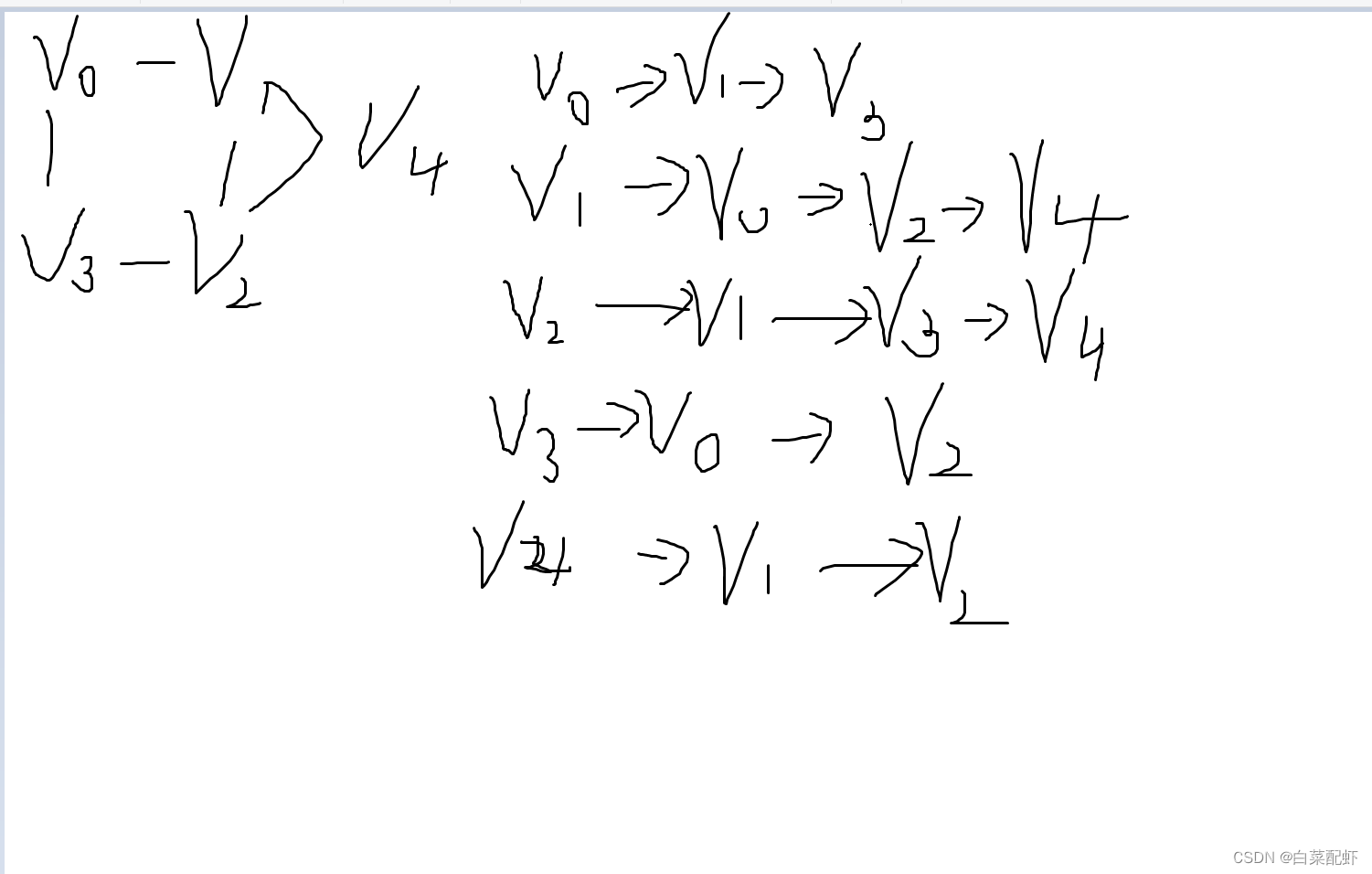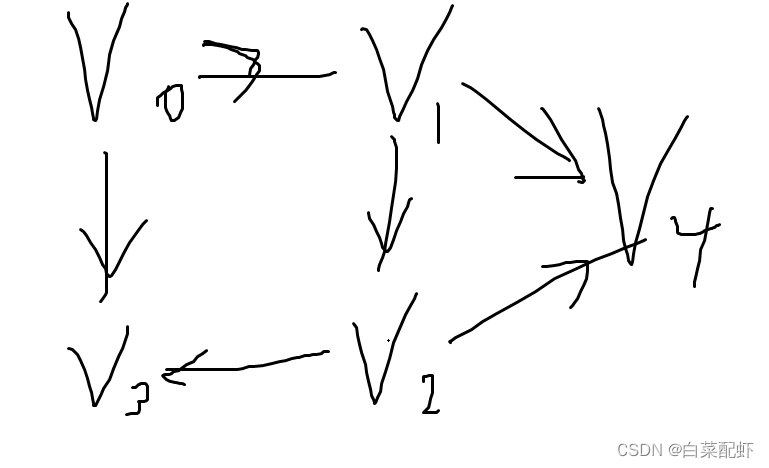邻接表,存储方法跟树的孩子链表示法相类似,是一种顺序分配和链式分配相结合的存储结构。如这个表头结点所对应的顶点存在相邻顶点,则把相邻顶点依次存放于表头结点所指向的单向链表中。
对于无向图来说,使用邻接表进行存储也会出现数据冗余,表头结点A所指链表中存在一个指向C的表结点的同时,表头结点C所指链表也会存在一个指向A的表结点。
图的邻接表存储方法跟树的孩子链表示法相类似,是一种顺序分配和链式分配相结合的存储结构。如这个表头结点所对应的顶点存在相邻顶点,则把相邻顶点依次存放于表头结点所指向的单向链表中。如词条概念图所示,表结点存放的是邻接顶点在数组中的索引。对于无向图来说,使用邻接表进行存储也会出现数据冗余,表头结点A所指链表中存在一个指向C的表结点的同时,表头结点C所指链表也会存在一个指向A的表结点。
#include <stdio.h>
#include <malloc.h>
#define QUEUE_SIZE 10
int* visitedPtr;
typedef struct Graph{
int** connections;
int numNodes;
} *GraphPtr;
GraphPtr initGraph(int paraSize, int** paraData) {
int i, j;
GraphPtr resultPtr = (GraphPtr)malloc(sizeof(struct Graph));
resultPtr -> numNodes = paraSize;
resultPtr -> connections = (int**)malloc(paraSize * sizeof(int*));
for (i = 0; i < paraSize; i ++) {
resultPtr -> connections[i] = (int*)malloc(paraSize * sizeof(int));
for (j = 0; j < paraSize; j ++) {
resultPtr -> connections[i][j] = paraData[i][j];
}
}
return resultPtr;
}
typedef struct GraphNodeQueue{
int* nodes;
int front;
int rear;
}GraphNodeQueue, *QueuePtr;
QueuePtr initQueue(){
QueuePtr resultQueuePtr = (QueuePtr)malloc(sizeof(struct GraphNodeQueue));
resultQueuePtr->nodes = (int*)malloc(QUEUE_SIZE * sizeof(int));
resultQueuePtr->front = 0;
resultQueuePtr->rear = 1;
return resultQueuePtr;
}
bool isQueueEmpty(QueuePtr paraQueuePtr){
if ((paraQueuePtr->front + 1) % QUEUE_SIZE == paraQueuePtr->rear) {
return true;
}
return false;
}
void enqueue(QueuePtr paraQueuePtr, int paraNode){
if ((paraQueuePtr->rear + 1) % QUEUE_SIZE == paraQueuePtr->front % QUEUE_SIZE) {
printf("Error, trying to enqueue %d. queue full.\r\n", paraNode);
return;
}
paraQueuePtr->nodes[paraQueuePtr->rear] = paraNode;
paraQueuePtr->rear = (paraQueuePtr->rear + 1) % QUEUE_SIZE;
}
int dequeue(QueuePtr paraQueuePtr){
if (isQueueEmpty(paraQueuePtr)) {
printf("Error, empty queue\r\n");
return NULL;
}
paraQueuePtr->front = (paraQueuePtr->front + 1) % QUEUE_SIZE;
return paraQueuePtr->nodes[paraQueuePtr->front];
}
typedef struct AdjacencyNode {
int column;
AdjacencyNode* next;
}AdjacencyNode, *AdjacentNodePtr;
typedef struct AdjacencyList {
int numNodes;
AdjacencyNode* headers;
}AdjacencyList, *AdjacencyListPtr;
AdjacencyListPtr graphToAdjacentList(GraphPtr paraPtr) {
int i, j, tempNum;
AdjacentNodePtr p, q;
tempNum = paraPtr->numNodes;
AdjacencyListPtr resultPtr = (AdjacencyListPtr)malloc(sizeof(struct AdjacencyList));
resultPtr->numNodes = tempNum;
resultPtr->headers = (AdjacencyNode*)malloc(tempNum * sizeof(struct AdjacencyNode));
for (i = 0; i < tempNum; i ++) {
p = &(resultPtr->headers[i]);
p->column = -1;
p->next = NULL;
for (j = 0; j < tempNum; j ++) {
if (paraPtr->connections[i][j] > 0) {
q = (AdjacentNodePtr)malloc(sizeof(struct AdjacencyNode));
q->column = j;
q->next = NULL;
p->next = q;
p = q;
}
}
}
return resultPtr;
}
void printAdjacentList(AdjacencyListPtr paraPtr) {
int i;
AdjacentNodePtr p;
int tempNum = paraPtr->numNodes;
printf("这就是宁要的邻接表:\r\n");
for (i = 0; i < tempNum; i ++) {
p = paraPtr->headers[i].next;
while (p != NULL) {
printf("%d, ", p->column);
p = p->next;
}
printf("\r\n");
}
}
void widthFirstTranverse(AdjacencyListPtr paraListPtr, int paraStart){
printf("width first \r\n");
int i, j, tempNode;
AdjacentNodePtr p;
i = 0;
visitedPtr = (int*) malloc(paraListPtr->numNodes * sizeof(int));
for (i = 0; i < paraListPtr->numNodes; i ++) {
visitedPtr[i] = 0;
}
QueuePtr tempQueuePtr = initQueue();
printf("%d\t", paraStart);
visitedPtr[paraStart] = 1;
enqueue(tempQueuePtr, paraStart);
while (!isQueueEmpty(tempQueuePtr)) {
tempNode = dequeue(tempQueuePtr);
for (p = &(paraListPtr->headers[tempNode]); p != NULL; p = p->next) {
j = p->column;
if (visitedPtr[j]) //如果if通过,那么进行下一个循环嗷
continue;
printf("%d\t", j);
visitedPtr[j] = 1; //用过啦
enqueue(tempQueuePtr, j); //进去啊
}
}
printf("\r\n");
}
void testGraphTranverse() {
int i, j;
int myGraph[5][5] = {
{0, 1, 0, 1, 0},
{1, 0, 1, 0, 1},
{0, 1, 0, 1, 1},
{1, 0, 1, 0, 0},
{0, 1, 1, 0, 0}};
int** tempPtr;
printf("准备数据嗷 0就是没关系,1就是有关系\r\n");
tempPtr = (int**)malloc(5 * sizeof(int*));
for (i = 0; i < 5; i ++) {
tempPtr[i] = (int*)malloc(5 * sizeof(int));
}//Of for i
for (i = 0; i < 5; i ++) {
for (j = 0; j < 5; j ++) {
tempPtr[i][j] = myGraph[i][j];
printf("i = %d, j = %d, %d\r\n", i, j, tempPtr[i][j]);
}
}
printf("数据在上嗷\r\n");
GraphPtr tempGraphPtr = initGraph(5, tempPtr);
AdjacencyListPtr tempListPtr = graphToAdjacentList(tempGraphPtr);
printAdjacentList(tempListPtr);
widthFirstTranverse(tempListPtr, 4);
}
int main(){
testGraphTranverse();
return 1;
}
运算结果:
准备数据嗷 0就是没关系,1就是有关系
i = 0, j = 0, 0
i = 0, j = 1, 1
i = 0, j = 2, 0
i = 0, j = 3, 1
i = 0, j = 4, 0
i = 1, j = 0, 1
i = 1, j = 1, 0
i = 1, j = 2, 1
i = 1, j = 3, 0
i = 1, j = 4, 1
i = 2, j = 0, 0
i = 2, j = 1, 1
i = 2, j = 2, 0
i = 2, j = 3, 1
i = 2, j = 4, 1
i = 3, j = 0, 1
i = 3, j = 1, 0
i = 3, j = 2, 1
i = 3, j = 3, 0
i = 3, j = 4, 0
i = 4, j = 0, 0
i = 4, j = 1, 1
i = 4, j = 2, 1
i = 4, j = 3, 0
i = 4, j = 4, 0
数据在上嗷
这就是宁要的邻接表:
1, 3,
0, 2, 4,
1, 3, 4,
0, 2,
1, 2,
width first
4 1 2 0 3附加图片方便大家理解这个答案是什么意思:
这题是个无向图欸,如果是有向图的话......
比如
那答案就是
V0 : ->1->3
V1: ->2->4
V2: ->3->4
V3:
V4:
为什么不画图,因为太丑啦!
#include <stdio.h>
#include <stdlib.h>
#include <malloc.h>
#include <string.h>
#include <iostream>
using namespace std;
typedef char VertexType[4];
typedef char InfoPtr;
typedef int VRType;
#define MAXSIZE 100
typedef enum {DG,DN,UG,UN}GraphKind;
typedef struct ArcNode
{
int adjvex;
InfoPtr *info;
struct ArcNode *nextarc;
}ArcNode;
typedef struct VNode
{
VertexType data;
ArcNode *firstarc;
}VNode,AdjList[MAXSIZE];
typedef struct
{
AdjList vertex;
int vexnum, arcnum;
GraphKind kind;
}AdjGraph;
int LocateVertex(AdjGraph G, VertexType v);
void CreateGraph(AdjGraph *G);
void DisplayGraph(AdjGraph G);
void DestoryGraph(AdjGraph *G);
int LocateVertex(AdjGraph G, VertexType v)
{
int i;
for (i = 0; i < G.vexnum; ++i)
{
if (strcmp(G.vertex[i].data, v) == 0)
{
return i;
}
}
return -1;
}
void CreateGraph(AdjGraph *G)
{
int i, j, k;
VertexType v1, v2;
ArcNode *p;
cout << "请输入图的顶点数和边数 ";
cin >> (*G).vexnum >> (*G).arcnum;
cout << "请输入" <<G->vexnum<< "个顶点的值:" << endl;
for (i = 0; i < G->vexnum;i++)
{
cin >> G->vertex[i].data;
G->vertex[i].firstarc = NULL;
}
cout << "请输入弧尾 弧头" << endl;
for (k = 0; k < G->arcnum;k++)
{
cin >> v1 >> v2;
i = LocateVertex(*G, v1);
j = LocateVertex(*G, v2);
p = (ArcNode*)malloc(sizeof(ArcNode));
p->adjvex = j;
p->info = NULL;
p->nextarc = G->vertex[i].firstarc;
G->vertex[i].firstarc = p;
}
(*G).kind = DG;
}
void DestoryGraph(AdjGraph *G)
{
int i;
ArcNode *p, *q;
for (i = 0; i < (*G).vexnum;i++)
{
p = G->vertex[i].firstarc;
if (p!=NULL)
{
q = p->nextarc;
free(p);
p = q;
}
}
(*G).vexnum = 0;
(*G).arcnum = 0;
}
void DisplayGraph(AdjGraph G)
{
int i;
ArcNode *p;
cout << G.vexnum << "个顶点:" << endl;
for (i = 0; i < G.vexnum;i++)
{
cout << G.vertex[i].data << " ";
}
cout << endl << G.arcnum << "条边:"<<endl;
for (i = 0; i < G.vexnum;i++)
{
p = G.vertex[i].firstarc;
while (p)
{
cout << G.vertex[i].data << "→" << G.vertex[p->adjvex].data << " ";
p = p->nextarc;
}
cout << endl;
}
}
int main()
{
AdjGraph G;
cout << "采用邻接矩阵创建有向图G:" << endl;
CreateGraph(&G);
cout << "输入有向图G的邻接表:" << endl;
DisplayGraph(G);
DestoryGraph(&G);
system("pause");
return 0;
}运算内容加结果:
采用邻接矩阵创建有向图G:
请输入图的顶点数和边数 6 9
请输入6个顶点的值:
a b c d e f
请输入弧尾 弧头
a b
a c
a f
f c
b c
c d
d a
e d
b f
输入有向图G的邻接表:
6个顶点:
a b c d e f
9条边:
a→f a→c a→b
b→f b→c
c→d
d→a
e→d
f→c
请按任意键继续. . .
结束.





















 3345
3345











 被折叠的 条评论
为什么被折叠?
被折叠的 条评论
为什么被折叠?








